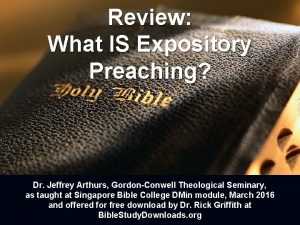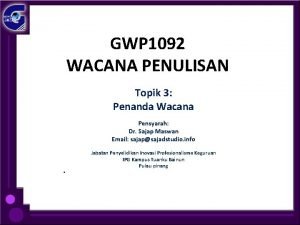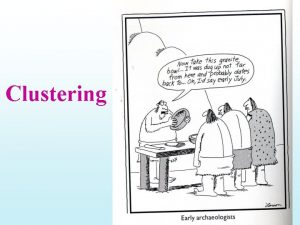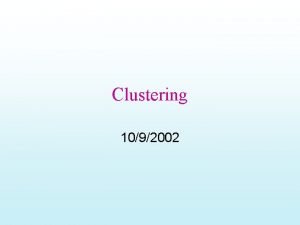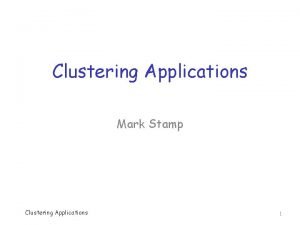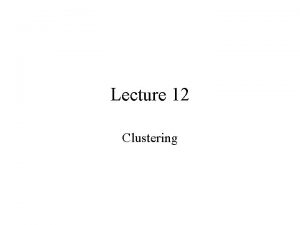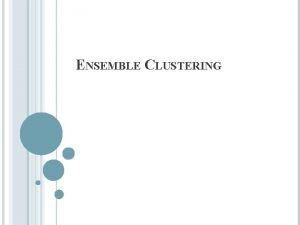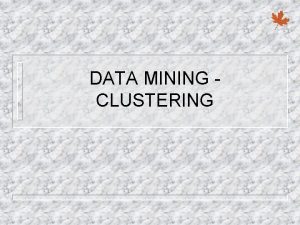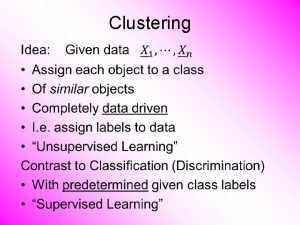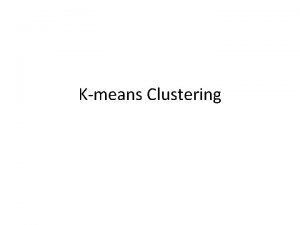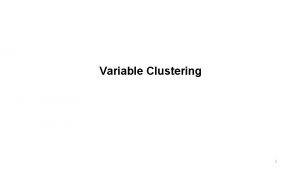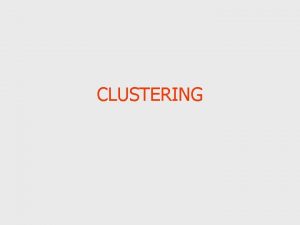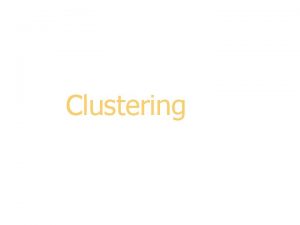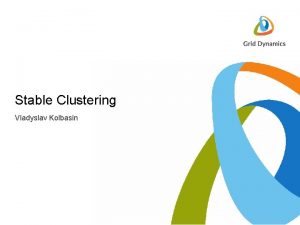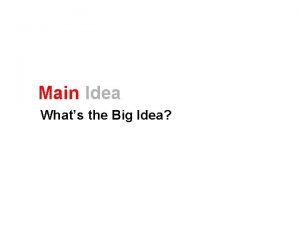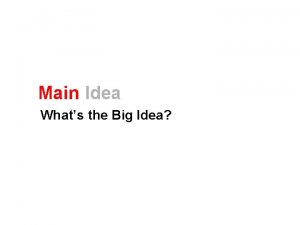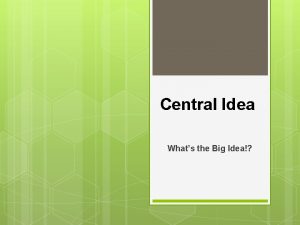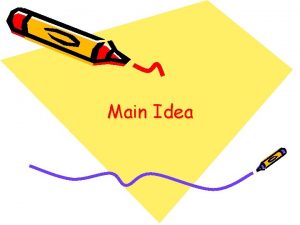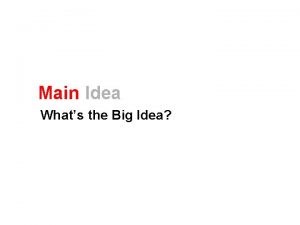Clustering Idea and Applications Clustering is the process

















![Example of K-means in operation [From Hand et. Al. ] Example of K-means in operation [From Hand et. Al. ]](https://slidetodoc.com/presentation_image/001d3adc1f7e40a4ebc39c3e287fd1c9/image-18.jpg)





















- Slides: 39

Clustering

Idea and Applications • Clustering is the process of grouping a set of physical or abstract objects into classes of similar objects. – It is also called unsupervised learning. – It is a common and important task that finds many applications. • Applications in Search engines: – – Improves recall Allows disambiguation Recovers missing details Structuring search results Suggesting related pages Automatic directory construction/update Finding near identical/duplicate pages



Clustering issues --Hard vs. Soft clusters --Distance measures cosine or Jaccard or. . --Cluster quality: Internal measures --intra-cluster tightness --inter-cluster separation External measures --How many points are put in wrong clusters. [From Mooney]

Cluster Evaluation – “Clusters can be evaluated with “internal” as well as “external” measures • Internal measures are related to the inter/intra cluster distance – A good clustering is one where » (Intra-cluster distance) the sum of distances between objects in the same cluster are minimized, » (Inter-cluster distance) while the distances between different clusters are maximized » Objective to minimize: F(Intra, Inter) • External measures are related to how representative are the current clusters to “true” classes. Measured in terms of purity, entropy or F-measure

Purity example Cluster II Cluster I: Purity = 1/6 (max(5, 1, 0)) = 5/6 Cluster II: Purity = 1/6 (max(1, 4, 1)) = 4/6 Cluster III: Purity = 1/5 (max(2, 0, 3)) = 3/5 Cluster III Overall Purity = weighted purity

Rand-Index: Precision/Recall based

Unsupervised? • Clustering is normally seen as an instance of unsupervised learning algorithm – So how can you have external measures of cluster validity? – The truth is that you have a continuum between unsupervised vs. supervised • Answer: Think of “no teacher being there” vs. “lazy teacher” who checks your work once in a while. • Examples: – Fully unsupervised (no teacher) – Teacher tells you how many clusters are there – Teacher tells you that certain pairs of points will fall or will not fill in the same cluster – Teacher may occasionally evaluate the goodness of your clusters (external measures of validity)

(Text Clustering) When & From What • Clustering can be done at: – Indexing time – At query time • Applied to documents • Applied to snippets Clustering can be based on: URL source Put pages from the same server together Text Content -Polysemy (“bat”, “banks”) -Multiple aspects of a single topic Links -Look at the connected components in the link graph (A/H analysis can do it) -look at co-citation similarity (e. g. as in collab filtering)

Inter/Intra Cluster Distances Intra-cluster distance/tightness • (Sum/Min/Max/Avg) the (absolute/squared) distance between - All pairs of points in the cluster OR - Between the centroid and all points in the cluster OR - Between the “medoid” and all points in the cluster Inter-cluster distance Sum the (squared) distance between all pairs of clusters Where distance between two clusters is defined as: - distance between their centroids/medoids - Distance between the closest pair of points belonging to the clusters (single link) - (Chain shaped clusters) - Distance between farthest pair of points (complete link) - (Spherical clusters)

How hard is clustering? • One idea is to consider all possible clusterings, and pick the one that has best inter and intra cluster distance properties • Suppose we are given n points, and would like to cluster them into k-clusters – How many possible clusterings? • Too hard to do it brute force or optimally • Solution: Iterative optimization algorithms – Start with a clustering, iteratively improve it (eg. K-means)

Classical clustering methods • Partitioning methods – k-Means (and EM), k-Medoids • Hierarchical methods – agglomerative, divisive, BIRCH • Model-based clustering methods

K-means • Works when we know k, the number of clusters we want to find • Idea: – Randomly pick k points as the “centroids” of the k clusters – Loop: • For each point, put the point in the cluster to whose centroid it is closest • Recompute the cluster centroids • Repeat loop (until there is no change in clusters between two consecutive iterations. ) Iterative improvement of the objective function: Sum of the squared distance from each point to the centroid of its cluster (Notice that since K is fixed, maximizing tightness also maximizes inter-cluster distance)

Lower case Convergence of K-Means • Define goodness measure of cluster k as sum of squared distances from cluster centroid: – Gk = Σi (di – ck)2 (sum over all di in cluster k) • G = Σk G k • Reassignment monotonically decreases G since each vector is assigned to the closest centroid.

K-means Example • For simplicity, 1 -dimension objects and k=2. – Numerical difference is used as the distance • Objects: 1, 2, • K-means: 5, 6, 7 – Randomly select 5 and 6 as centroids; – => Two clusters {1, 2, 5} and {6, 7}; mean. C 1=8/3, mean. C 2=6. 5 – => {1, 2}, {5, 6, 7}; mean. C 1=1. 5, mean. C 2=6 – => no change. – Aggregate dissimilarity • (sum of squares of distanceeach point of each cluster from its cluster center--(intra-cluster distance) – = 0. 52+ 12+ 02+12 = 2. 5 |1 -1. 5|2

K Means Example (K=2) Pick seeds Reassign clusters Compute centroids Reasssign clusters x x Compute centroids Reassign clusters Converged! [From Mooney]
![Example of Kmeans in operation From Hand et Al Example of K-means in operation [From Hand et. Al. ]](https://slidetodoc.com/presentation_image/001d3adc1f7e40a4ebc39c3e287fd1c9/image-18.jpg)
Example of K-means in operation [From Hand et. Al. ]

Vector Quantization: K-means as Compression

Problems with. Why. K-means not the • Need to know k in advance – Could try out several k? minimum value? • Cluster tightness increases with increasing K. Example showing sensitivity to seeds – Look for a kink in the tightness vs. K curve • Tends to go to local minima that are sensitive to the starting centroids – Try out multiple starting points • Disjoint and exhaustive – Doesn’t have a notion of “outliers” • Outlier problem can be handled by K -medoid or neighborhood-based algorithms • Assumes clusters are spherical in vector space – Sensitive to coordinate changes, weighting etc. In the above, if you start with B and E as centroids you converge to {A, B, C} and {D, E, F} If you start with D and F you converge to {A, B, D, E} {C, F}

Looking for knees in the sum of intra-cluster dissimilarity

Penalize lots of clusters • For each cluster, we have a Cost C. • Thus for a clustering with K clusters, the Total Cost is KC. • Define the Value of a clustering to be = Total Benefit - Total Cost. • Find the clustering of highest value, over all choices of K. – Total benefit increases with increasing K. But can stop when it doesn’t increase by “much”. The Cost term enforces this.

3/8

Time Complexity • Assume computing distance between two instances is O(m) where m is the dimensionality of the vectors. • Reassigning clusters: O(kn) distance computations, or O(knm). • Computing centroids: Each instance vector gets added once to some centroid: O(nm). • Assume these two steps are each done once for I iterations: O(Iknm). • Linear in all relevant factors, assuming a fixed number of iterations, – more efficient than O(n 2) HAC (to come next)

Variations on K-means • Recompute the centroid after every (or few) changes (rather than after all the points are Lowest aggregate Dissimilarity re-assigned) – Improves convergence speed (intra-cluster distance) • Starting centroids (seeds) change which local minima we converge to, as well as the rate of convergence – Use heuristics to pick good seeds • Can use another cheap clustering over random sample – Run K-means M times and pick the best clustering that results • Bisecting K-means takes this idea further…

1 d o eth m d i r Bisecting K-means b y H • For I=1 to k-1 do{ Can pick the largest Cluster or the cluster With lowest average similarity – Pick a leaf cluster C to split – For J=1 to ITER do{ • Use K-means to split C into two sub-clusters, C 1 and C 2 • Choose the best of the above splits and make it permanent} } Divisive hierarchical clustering method uses K-means

Variations on K-means (contd) • Outlier problem – Use K-Medoids • Costly! • Non-hard clusters – Use soft K-means • Let the membership of each data point in a cluster be proportional to its distance from that cluster center • Membership weight of elt e in cluster C is Exp(-b dist(e; center(C)) » Normalize the weight vector – Normal K-means takes the max of weights and assigns it to that cluster » The cluster center re-computation step is based on the membership – We can instead let the cluster center computation be based on the all points, weighted by their membership weight

Semi-supervised variations of Kmeans • Often we know partial knowledge about the clusters – E. g. We may know that the text docs are in two clusters—one related to finance and the other to CS. – Moreover, we may know that certain specific docs are CS and certain others are finance – How can we use it? • Partial knowledge can be used to set the initial seeds of the K-means

Hierarchical Clustering Techniques • Generate a nested (multiresolution) sequence of clusters • Two types of algorithms – Divisive • Start with one cluster and recursively subdivide • Bisecting K-means is an example! – Agglomerative (HAC) • Start with data points as single point clusters, and recursively merge the closest clusters “Dendogram”

Hierarchical Agglomerative Clustering Example • {Put every point in a cluster by itself. For I=1 to N-1 do{ let C 1 and C 2 be the most mergeable pair of clusters (defined as the two closest clusters) Create C 1, 2 as parent of C 1 and C 2} • Example: For simplicity, we still use 1 -dimensional objects. – Numerical difference is used as the distance • Objects: 1, 2, 5, 6, 7 • agglomerative clustering: – – find two closest objects and merge; => {1, 2}, so we have now {1. 5, 5, 6, 7}; => {1, 2}, {5, 6}, so {1. 5, 5. 5, 7}; => {1, 2}, {{5, 6}, 7}. 1 2 5 6 7

Single Link Example

Complete Link Example

Impact of cluster distance measures “Single-Link” (inter-cluster distance= distance between closest pair of points) [From Mooney] “Complete-Link” (inter-cluster distance= distance between farthest pair of points)

Group-average Similarity based clustering • Instead of single or complete link, we can consider cluster distance in terms of average distance of all pairs of points from each cluster • Problem: n*m similarity computations • Thankfully, this is much easier with cosine similarity…

Properties of HAC • Creates a complete binary tree (“Dendogram”) of clusters • Various ways to determine mergeability – “Single-link”—distance between closest neighbors – “Complete-link”—distance between farthest neighbors – “Group-average”—average distance between all pairs of neighbors – “Centroid distance”—distance between centroids is the most common measure • Deterministic (modulo tie-breaking) • Runs in O(N 2) time • People used to say this is better than Kmeans • But the Stenbach paper says K-means and bisecting Kmeans are actually better

2 d o eth yb m d i r H Buckshot Algorithm • Combines HAC and K-Means clustering. • First randomly take a sample of instances of size n • Run group-average HAC on this sample, which takes only O(n) time. • Use the results of HAC as initial seeds for K -means. • Overall algorithm is O(n) and avoids problems of bad seed selection. Uses HAC to bootstrap K-means Cut where You have k clusters

Text Clustering • HAC and K-Means have been applied to text in a straightforward way. • Typically use normalized, TF/IDF-weighted vectors and cosine similarity. • Cluster Summaries are computed by using the words that have highest tf/icf value (i. c. f Inverse cluster frequency) • Optimize computations for sparse vectors. • Applications: – During retrieval, add other documents in the same cluster as the initial retrieved documents to improve recall. – Clustering of results of retrieval to present more organized results to the user (à la Northernlight folders). – Automated production of hierarchical taxonomies of documents for browsing purposes (à la Yahoo & DMOZ).

Which of these are the best for text? • Bisecting K-means and K-means seem to do better than Agglomerative Clustering techniques for Text document data [Steinbach et al] – “Better” is defined in terms of cluster quality • Quality measures: – Internal: Overall Similarity – External: Check how good the clusters are w. r. t. user defined notions of clusters

Challenges/Other Ideas • High dimensionality – Most vectors in high-D spaces will be orthogonal – Do LSI analysis first, project data into the most important m-dimensions, and then do clustering • E. g. Manjara • Phrase-analysis (a better distance and so a better clustering) – Sharing of phrases may be more indicative of similarity than sharing of words • (For full WEB, phrasal analysis was too costly, so we went with vector similarity. But for top 100 results of a query, it is possible to do phrasal analysis) • Suffix-tree analysis • Shingle analysis • Using link-structure in clustering • A/H analysis based idea of connected components • Co-citation analysis • Sort of the idea used in Amazon’s collaborative filtering • Scalability – More important for “global” clustering – Can’t do more than one pass; limited memory – See the paper – Scalable techniques for clustering the web – Locality sensitive hashing is used to make similar documents collide to same buckets
 Flat and hierarchical clustering
Flat and hierarchical clustering L
L Rumus euclidean
Rumus euclidean Hierarchical clustering applications
Hierarchical clustering applications Is the theme the main idea
Is the theme the main idea Supporting idea adalah
Supporting idea adalah Is the main idea the theme
Is the main idea the theme Topic sentence supporting sentence concluding sentence
Topic sentence supporting sentence concluding sentence What is the implied main idea of the passage?
What is the implied main idea of the passage? Exegetical idea vs homiletical idea
Exegetical idea vs homiletical idea Definisi penanda wacana
Definisi penanda wacana Hình ảnh bộ gõ cơ thể búng tay
Hình ảnh bộ gõ cơ thể búng tay Bổ thể
Bổ thể Tỉ lệ cơ thể trẻ em
Tỉ lệ cơ thể trẻ em Chó sói
Chó sói Thang điểm glasgow
Thang điểm glasgow Hát lên người ơi
Hát lên người ơi Môn thể thao bắt đầu bằng chữ f
Môn thể thao bắt đầu bằng chữ f Thế nào là hệ số cao nhất
Thế nào là hệ số cao nhất Các châu lục và đại dương trên thế giới
Các châu lục và đại dương trên thế giới Công của trọng lực
Công của trọng lực Trời xanh đây là của chúng ta thể thơ
Trời xanh đây là của chúng ta thể thơ Mật thư tọa độ 5x5
Mật thư tọa độ 5x5 101012 bằng
101012 bằng Phản ứng thế ankan
Phản ứng thế ankan Các châu lục và đại dương trên thế giới
Các châu lục và đại dương trên thế giới Thơ thất ngôn tứ tuyệt đường luật
Thơ thất ngôn tứ tuyệt đường luật Quá trình desamine hóa có thể tạo ra
Quá trình desamine hóa có thể tạo ra Một số thể thơ truyền thống
Một số thể thơ truyền thống Cái miệng bé xinh thế chỉ nói điều hay thôi
Cái miệng bé xinh thế chỉ nói điều hay thôi Vẽ hình chiếu vuông góc của vật thể sau
Vẽ hình chiếu vuông góc của vật thể sau Nguyên nhân của sự mỏi cơ sinh 8
Nguyên nhân của sự mỏi cơ sinh 8 đặc điểm cơ thể của người tối cổ
đặc điểm cơ thể của người tối cổ Thứ tự các dấu thăng giáng ở hóa biểu
Thứ tự các dấu thăng giáng ở hóa biểu Vẽ hình chiếu đứng bằng cạnh của vật thể
Vẽ hình chiếu đứng bằng cạnh của vật thể Fecboak
Fecboak Thẻ vin
Thẻ vin đại từ thay thế
đại từ thay thế điện thế nghỉ
điện thế nghỉ









